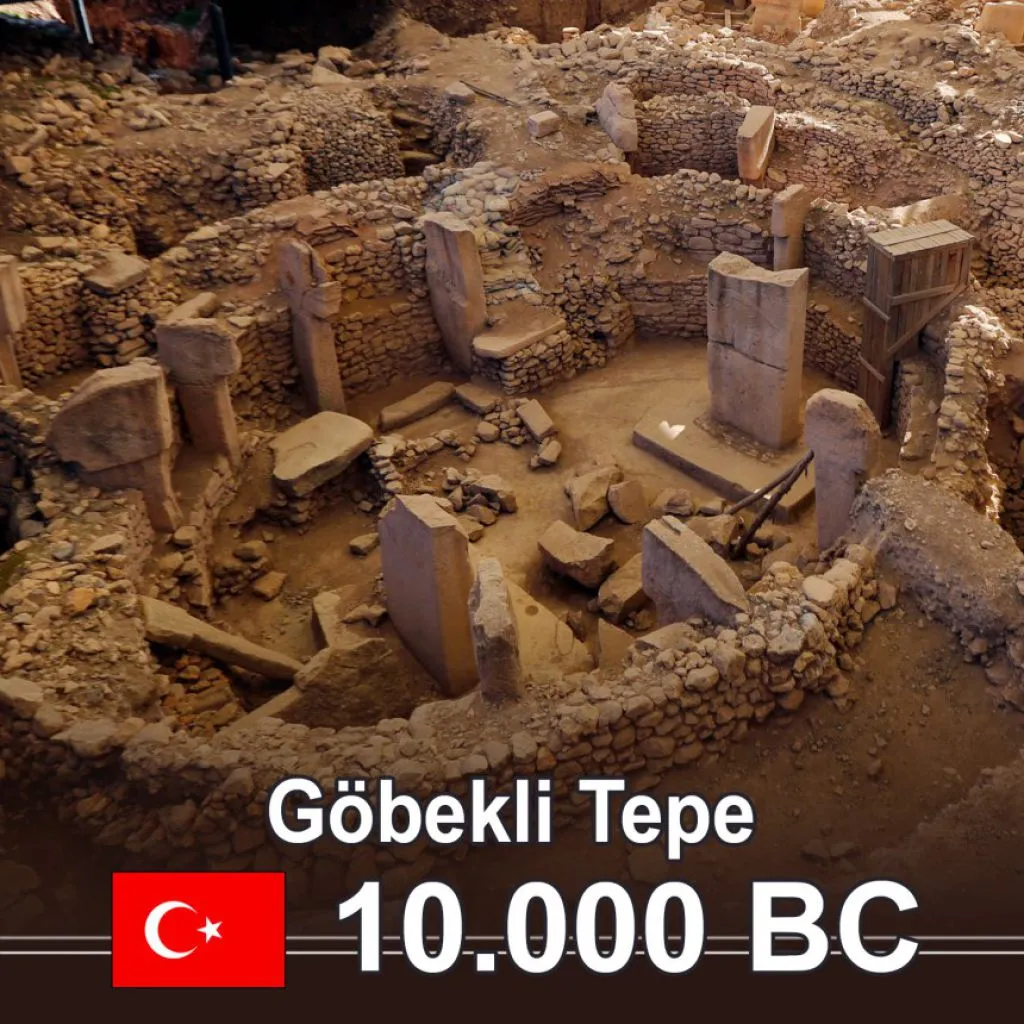
Göbekli Tepe
Göbekli Tepe, Turkish for "Potbelly Hill", is an archaeological site in the Southeastern Anatolia Region of Turkey, approximately 12 km (7 mi) northeast of the city of Şanlıurfa. The tell has a height of 15 m (49 ft) and is about 300 m (980 ft) in diamete
The tell includes two phases of use believed to be of a social or ritual nature dating back to the 10th–8th millennium BCE. During the first phase, belonging to the Pre-Pottery Neolithic A (PPNA), circles of massive T-shaped stone pillars were erected, the world's oldest known megaliths. More than 200 pillars in about 20 circles are currently known through geophysical surveys. Each pillar has a height of up to 6 m (20 ft) and weighs up to 10 tons. They are fitted into sockets that were hewn out of the bedrock. In the second phase, belonging to the Pre-Pottery Neolithic B (PPNB), the erected pillars are smaller and stood in rectangular rooms with floors of polished lime. The site was abandoned after the PPNB. Younger structures date to classical times.
The details of the structure's function remain a mystery. It was excavated by a German archaeological team under the direction of Klaus Schmidt from 1996 until his death in 2014. Schmidt believed that the site was a sanctuary where people from a wide region periodically congregated, not a settlement.
The site was deliberately backfilled sometime after 8000 BCE. The buildings were buried under debris, mostly flint gravel, stone tools, and animal bones. In addition to Byblos points (weapon heads, i.e. arrowheads etc.) and numerous Nemrik points, Helwan-points and Aswad-points dominate the backfill's lithic inventory.
DISCOVERY
The site was first noted in a survey conducted by Istanbul University and the University of Chicago in 1963. American archaeologist Peter Benedict identified lithics collected from the surface of the site as belonging to the Aceramic Neolithic, but mistook the stone slabs (the upper parts of the T-shaped pillars) for grave markers, postulating that the prehistoric phase was overlain by a Byzantine cemetery. The hill had long been under agricultural cultivation, and generations of local inhabitants had frequently moved rocks and placed them in clearance piles, which may have disturbed the upper layers of the site. At some point attempts had been made to break up some of the pillars, presumably by farmers who mistook them for ordinary large rocks.
In 1994, Klaus Schmidt of the German Archaeological Institute, who had previously been working at Nevalı Çori, was looking for another site to excavate. He reviewed the archaeological literature on the surrounding area, found the 1963 Chicago researchers’ brief description of Göbekli Tepe, and decided to reexamine the site. Having found similar structures at Nevalı Çori, he recognized the possibility that the rocks and slabs were prehistoric. The following year, he began excavating there in collaboration with the Şanlıurfa Museum, and soon unearthed the first of the huge T-shaped pillars.
IMPORTANCE
Göbekli Tepe is regarded by some as an archaeological discovery of the greatest importance since it could profoundly change the understanding of a crucial stage in the development of human society. Ian Hodder of Stanford University said, "Göbekli Tepe changes everything". If indeed the site was built by hunter-gatherers as some researchers believe then it would mean that the ability to erect monumental complexes was within the capacities of these sorts of groups which would overturn previous assumptions. Some researchers believe that the construction of Göbekli Tepe may have contributed to the later development of urban civilization. As excavator Klaus Schmidt put it: "First came the temple, then the city."
Not only its large dimensions, but the side-by-side existence of multiple pillar shrines makes the location unique. There are no comparable monumental complexes from its time. However, since its discovery surface surveys have shown that several hills in the greater area also have T-shaped stone pillars (e.g. Hamzan Tepe, Karahan Tepe, Harbetsuvan Tepesi, Sefer Tepe, Taslı Tepe), but there has so far not been much excavation done. Most of these constructions seem to be smaller than Göbekli Tepe, and their placement evenly between contemporary settlements indicates that they were local social/ritual gathering places, with Göbekli Tepe maybe as a regional centre. So far none of the smaller sites are as old as the lowest Level III of Göbekli Tepe, but contemporary with its younger Level II (mostly rectangular buildings, though Harbetsuvan is circular). This could indicate that this type of architecture and associated activities originated at Göbekli Tepe and then spread to other sites.
A 500 years younger site is Nevalı Çori. Its T-shaped pillars are considerably smaller, and its rectangular shrine was located inside a village. The roughly contemporary architecture at Jericho is devoid of artistic merit or large-scale sculpture, and Çatalhöyük, perhaps the most famous Anatolian Neolithic village, is 2,000 years later.
At present Göbekli Tepe raises more questions for archaeology and prehistory than it answers. It remains unknown how a force large enough to construct, augment, and maintain such a substantial complex was mobilized and compensated or fed in the conditions of pre-sedentary society. Scholars cannot interpret the pictograms, and do not know for certain what meaning the animal reliefs had for visitors to the site; the variety of fauna depicted, from lions and boars to birds and insects, makes any single explanation problematic. As there is little or no evidence of habitation, and the animals pictured are mainly predators, the stones may have been intended to stave off evils through some form of magic representation. Alternatively, they could have served as totems. The assumption that the site was strictly cultic in purpose and not inhabited has also been challenged by the suggestion that the structures served as large communal houses, "similar in some ways to the large plank houses of the Northwest Coast of North America with their impressive house posts and totem poles." It is not known why every few decades the existing pillars were buried to be replaced by new stones as part of a smaller, concentric ring inside the older one. Human burial may have occurred at the site. The reason the complex was carefully backfilled remains unexplained. Until more evidence is gathered, it is difficult to deduce anything certain about the originating culture or the site's significance.
















































